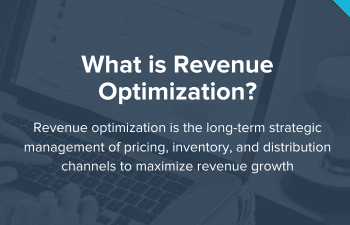If your eCommerce business has stalled—or you want to make sure it doesn’t—consider revenue optimization. Implementing a revenue optimization strategy will ensure that you’re always looking for new opportunities to improve, which means you’re much less likely to hit a plateau.
What is Revenue Optimization?
Revenue optimization is the ongoing process of adjusting your marketing mix to maximize your return on investment.
The marketing mix, also known as the 4 Ps, is made up of:
- Product. The product component includes factors like the product lifecycle, changes to your product, product quality.
- Price. This component includes pricing for different products and add-ons, along with discounts and other offers.
- Place. Place has to do with where the product is sold and how it is distributed.
- Promotion. The promotional component includes any PR, marketing, or advertising efforts.
By optimizing your product, price, distribution, and promotion strategies, you can make incremental gains that lead to higher profit margins in the long run.
How Revenue Optimization Works
Changes to your marketing mix can increase revenue in five primary ways.
- Bringing back existing customers
- Enticing customers to make larger purchases
- Bringing in new customers
- Reducing marketing costs
- Reducing product-associated costs
It’s critical to bring in the most valuable customers as affordably as possible, and that’s where revenue optimization comes in.
Key Metrics
The key metrics to consider are:
- Customer Acquisition Cost (CAC) is how much it costs to acquire a new customer on average.
- Average Order Value (AOV) is the average amount a customer spends on a single order.
- Purchase Frequency is the average number of orders a customer places within a given period of time.
- Customer Lifetime Value (CLV) is the amount the average customer spends in total.
CLV is AOV multiplied by Purchase Frequency, so you can just look at CAC and CLV to make things easier. Your revenue optimization strategy should aim to find ways to lower CAC while increasing CLV.
Revenue Optimization Checklist
Here are a few things you can experiment with for each element of the marketing mix. Again, the goal is to find tactics that reduce CAC while increasing or maintaining CLV. Over time, consistent implementation of an effective revenue optimization strategy should maximize profits and growth.
Product Optimization
- Tweak your unique selling proposition to set yourself apart from competitors.
- Add a new feature to satisfy the needs of your customers.
- Make sure your branding resonates with your market and meets customer expectations.
- Identify ways to reduce costs.
Price Optimization
- Offer less and more expensive line extensions.
- Experiment with different offers (discounts, rebates, free shipping, etc.).
- Try different approaches to pricing (e.g., cost-plus pricing, market-based pricing, or value-based pricing).
Place Optimization
- Experiment with new distribution channels.
- Remove underperforming distribution channels.
- Consider bringing on a sales representative.
- Make sure you’ve checked all the boxes of our eCommerce website checklist. New Research Based eCommerce Website Checklist to Increase Sales[1]
Promotion Optimization
- Implement or enhance eCommerce personalization.
- Improve email acquisition with website visitor identification.
- Try new audience segments.
Increase eCommerce Profitability Revenue Optimization
Your revenue optimization strategy (or lack thereof) will determine whether your company makes a profit or loses money in the long run. The tips above will help you find the channels and tactics that deliver the most valuable customers at the most affordable price. That way, you’ll continue to increase profits instead of hitting a plateau or, worse, losing money.
